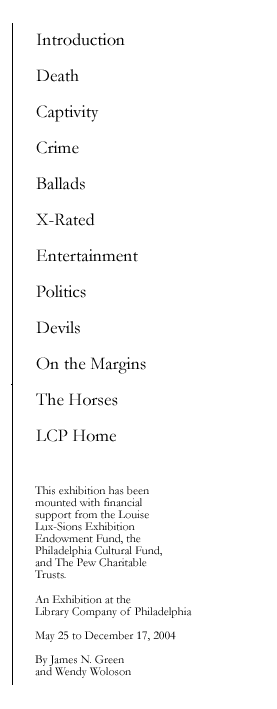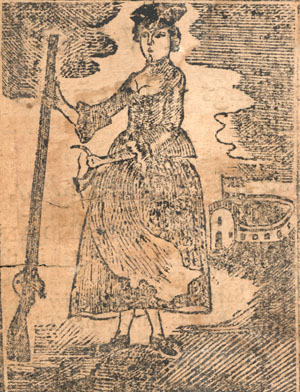

The conflict between Native Americans and the Europeans occupying their lands gave birth to a new genre, the captivity narrative. Indians traditionally took captives in battle for ransom or exchange of prisoners, and they continued this practice when they attacked White settlements. Today we enjoy the vicarious experience of violence on TV shows, even though we know they are at some level based on reality. Early American readers knew all too well how real these stories were. They were frightened by the captives’ ordeals but also reassured by the fact that they lived to tell the story, and by their obsessive assertion of cultural, religious, and racial superiority over their Indian captors.
Good Fetch’ out of Evil. [Boston, 1706?].
This anthology, possibly edited by Cotton Mather, contains narratives from several captives taken during Queen Anne’s War, including the earliest account of John Williams’ experiences. It is open to William Clap’s instances of “Astonishing Deliverances,” where captives “on the point of Destruction” were saved by divine intervention. This copy lacks four leaves, but no complete copy is known.
Mary Rowlandson. A Narrative of the Captivity, Sufferings and Removes of Mrs. Mary Rowlandson. Boston: N. Coverly, 1770.
This is the first and most famous Indian captivity narrative. Mary Rowlandson was captured in an attack on Lancaster, Massachusetts in 1676, during King Philip’s War. She and 23 other women and children were held for over 11 weeks, moving from one camp to another. She was treated as a valuable hostage, and her ordeal ended when she was ransomed for £20. As wife of the town’s minister, she wrote of all the captives, but her own feelings are most powerfully rendered. She was prevailed upon to publish it in 1682. It was reprinted once in 1720, but this 1770 edition marks its emergence as a classic. It has been constantly in print ever since. The illustration of her carrying a rifle (reproduced on the cover) first appeared in this edition and is at odds with her passivity. In all probability it was first used to represent the former cross-dressing British soldier Hannah Snell in an earlier imprint that does not survive. Of the attack, Rowlandson wrote, “The Bullets flying thick, one went thorough my side, and the same (as would seem) thorough the Bowels and Hand of my poor Child in my Arms. One of my elder Sisters Children (named William) had then his Leg broke, which the Indians perceiving, they knockt him on the head. Thus were we butchered by those merciless Heathens, standing amazed, with the Blood running down to our heels.” see image below
John Williams. The Redeemed Captive Returning to Zion. A Faithful History of Remarkable Occurrences in the Captivity and the Deliverance of Mr. John Williams. Boston: B. Green, 1707.
This is the first edition of the second important captivity narrative after Mary Rowlandson’s. In 1704, during Queen Anne’s War, a band of French Canadians and their Indian allies attacked Deerfield, Massachusetts and carried off to Quebec 109 prisoners, including the pastor John Williams and his family. The French tried to convert them, but Williams fortified his flock in their Protestant faith, except for his own seven-year-old daughter, Eunice, who became a Catholic and eventually married a Mohawk Indian. He was released in a prisoner exchange in 1706. Of his forced march to Canada, he wrote, “After prayer, I arose from my knees, but my feet were so Tender, Swoln, Bruised, and full of Pain, that I could scarce stand upon them, without holding on the Wigwam. And when the Indians said, You must run to day; I answered, I could not run: My Master pointing out to his Hatchet, said to me, Then I must dash out your Brains, and take off your Scalp. I said I suppose then you will do so, for I am not able to Travel with speed.”
A Surprising Account of the Captivity and Escape of Philip M’Donald & Alexander M’Leod, of Virginia. From the Chickkemogga Indians. Amherst, N.H.: N. Coverly, 1796.
A previously unknown edition of this popular captivity narrative first published in 1786. It opens with a horrific account of a burning at the stake. Later the heroes meet up with one of the lost tribes of Israel, who speak classical Hebrew and convey them to the Pacific Ocean in a preview of the Lewis and Clark Expedition. This is presumably fiction, an early example of a genre cross-over that became common in the 19th century.
Anthony Aufrer. The Cannibals’ progress; or The dreadful horrors of French invasion, as displayed by the Republican officers and soldiers, in their perfidy, rapacity, ferociousness, and brutality, exercised towards the innocent inhabitants of Germany. Hartford: Hudson [&] Goodwin, 1798.
Akin to captivity narratives were sensational descriptions of atrocities, such as this pamphlet about the pillage and rape of civilians by the French army in Germany. It pulls out all the stops in an effort to arouse prurient disgust. “Even the bodies of young women, who had expired under their barbarity, and of women who but a few hours before had been in labour, were made use of to satiate the infernal lust of these monsters in human shape.”
John Coustos. Horrid tortures; or, The unparalleled sufferings of John Coustos: who nine times underwent the most cruel tortures ever invented by man … by command of the inquisitors of Lisbon, in order to extort from him the secrets of Free-Masonry. Putney (Vt.): J. Hinds, 1798.
A captivity narrative where the barbarous Other is the Catholic Inquisition; the promise of a glimpse into the secrets of Masonry adds another seductive twist to the genre. The tortures are truly horrid, and graphically described.
Daniel Saunders. A journal of the travels and sufferings of Daniel Saunders, Jun., a mariner [who] was cast away near Cape Morebet, on the coast of Arabia. Leominster, Mass.: C. Prentiss for R. Thomas, Sterling, 1797.
Robert B. Thomashas for sale at his Book & Stationary store, in Sterling… Leominster: C. Prentiss, 1796.
This account of American castaways in the Arabian desert shares some of the features of a captivity narrative: the struggle for survival in the wilderness, the utter isolation in an alien culture. The sailors were rescued by Bedouins, who agreed to lead them to civilization, but only for an extortionate fee, justified by the circuitous route they took. Nine of the 18 men in the party died in the ordeal and one was enslaved. It is the sort of travel adventure that makes you glad you stayed at home. The publisher of this edition, Robert Thomas of Sterling, Massachusetts, had one of the largest country bookstores in the U.S. in the mid-1790s, as this leaflet shows. Saunders’ Journal is advertised along with four other books bearing his imprint. Note the large assortment of stationery and “Small Histories,” which were sold by peddlers.

